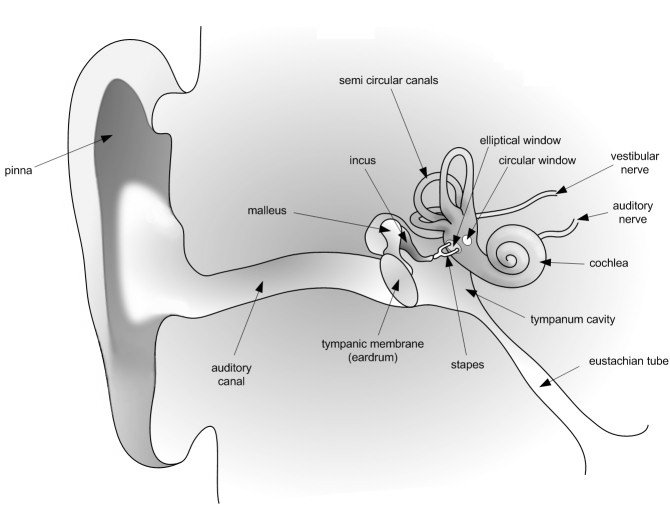10.6 The physics of hearing [NOT IN CAPS]
|
Previous
10.5 Ultrasound
|
Next
Chapter summary
|
10.6 The physics of hearing [NOT IN CAPS] (ESADG)

Figure 10.3: Diagram of the human ear.
The human ear is divided into three main sections: the outer, middle, and inner ear. Let's follow the journey of a sound wave from the pinna (outermost part) to the auditory nerve (innermost part) which transmits a signal to the brain. The pinna is the part of the ear we typically think of when we refer to the ear. Its main function is to collect and focus a sound wave. The wave then travels through the ear canal until it meets the eardrum. The pressure fluctuations of the sound wave make the eardrum vibrate. The three very small bones of the middle ear, the malleus (hammer), the incus (anvil), and the stapes (stirrup), transmit the signal through to the elliptical window. The elliptical window is the beginning of the inner ear. From the elliptical window the sound waves are transmitted through the liquid in the inner ear and interpreted as sounds by the brain. The inner ear, made of the semicircular canals, the cochlea, and the auditory nerve, is filled with fluid. The fluid allows the body to detect quick movements and maintain balance.
There are sounds which exceed the threshold of pain. Exposure to these sounds can cause immediate damage to hearing. In fact, exposure to sounds from \(\text{80}\) \(\text{dB}\) and above can damage hearing over time. Measures can be taken to avoid damage, such as wearing earplugs or ear muffs. Limiting exposure time and increasing distance between you and the source are also important steps for protecting your hearing.
Importance of Safety Equipment
Working in groups of 5, discuss the importance of safety equipment such as ear protectors for workers in loud environments, e.g. those who use jack hammers or direct aeroplanes to their parking bays. Write up your conclusions in a one page report. Some prior research into the importance of safety equipment might be necessary to complete this group discussion.
|
Previous
10.5 Ultrasound
|
Table of Contents |
Next
Chapter summary
|
